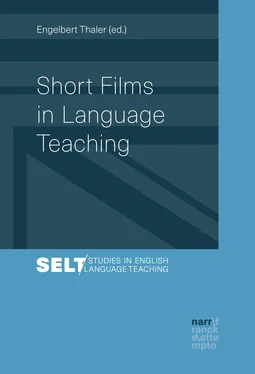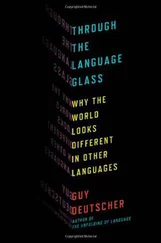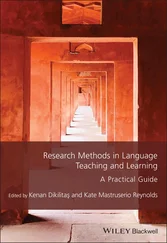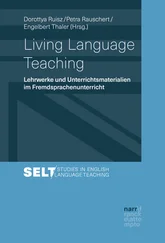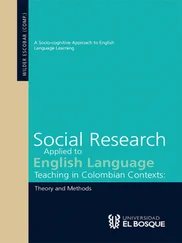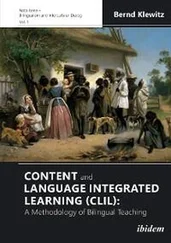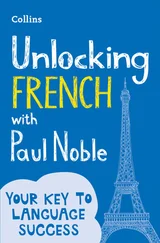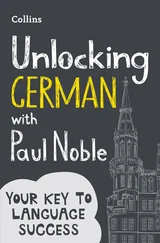To pronounce film a legitimate part of our culture and the cultural heritage ( Bildungsgut ) is all very well. Yet in these days, education aims not so much at cultural goods (like Shakespeare’s sonnets or Beethoven’s symphonies) but at abilities and skills which enable us to fulfill tasks, to solve problems, to cope with our lives. This focus on competences rather than contents is basically a sound idea. Cluttering up one’s mind with declarative knowledge makes little sense in a world in which knowledge evolves rapidly and becomes obsolete fast. On the other hand, competence-oriented education poses a latent threat to all things lacking immediate usefulness and to all abilities that have no tangible and measurable outcome. Art is such a thing; aesthetic sensitivity is such an ability. So why deal with films?
If the idea of film as a learning object will not suffice, film certainly qualifies as a learning medium, especially in teaching foreign languages and cultures:
Characters in foreign films speak foreign languages, so film may be used for listening to authentic native speakers.
Although films are never reflections but always models of reality (see Surkamp 2010: 94), they still convey images of historical or contemporary realities. We watch the melodrama FAR FROM HEAVEN (2002) and get an idea of what 1950s’ suburban culture in the U.S. was like. We watch HOUSE OF CARDS (2013 to present) and get an idea of how contemporary politics and government (probably, and horribly) work in the U.S.1
Films call for explanation and interpretation and thus provide occasions for speaking, reading, and writing: Is the ending in FAR FROM HEAVEN a happy one? What keeps the couple Frank and Claire in HOUSE OF CARDS together?
But neither FAR FROM HEAVEN nor HOUSE OF CARDS are short films. Short films can be defined as films not exceeding 30 minutes in duration (see Behrendt 2011: 396). Film history began with very short short films. Due to technical limitations early films (most notably by the brothers Lumière) would not even exceed one minute; and they were mainly used as entertainment attractions at vaudevilles and fun fares. Today, shortness is not so much a technical necessity but an artistic choice. And short films are no longer a means of ›lowly‹ mass amusement but rather a domain of ›high-brow‹ expertise. Apart from commercials, music videos, and the like, short films are no part of the popular cultural mainstream. They tend to appear at specialized festivals (e.g. Oberhausener Kurzfilmtage ), on quality television, and usually far removed from prime time slots (see Abraham 2013: 7).
If short films occupy cultural margins, why give them center (or any) stage in education?2 For one thing, public education is not merely to replicate cultural practices and aesthetic experiences students know from their everyday lives. Public education is to broaden and to deepen those practices and experiences. School is the place where especially children and young adults from underprivileged educational backgrounds ( bildungsfern ) may access cultural spheres otherwise beyond their reach: the library, the theater, the short film. A more pragmatic, if not trivial, reason for dealing with short films lies in their brevity. A full-length movie such as FAR FROM HEAVEN and even more so more than 50 episodes of HOUSE OF CARDS are hard to fit into the time frames of everyday teaching. The necessity turns into virtue, though, as precisely for their shortness, short films may be especially rich learning objects. Let us look at a case in point.
2 A Short Film as Rich Learning Object
2.1 Innertextual Aspects
Here is the story: It is a dark, rainy and thundery night. A man is sitting in the shelter of a tram stop. Out of nowhere appears an attractive woman, in an elegant dress. The man is about to help her out with some small change for the ticket machine and, seeing her freezing and with goose bumps, takes off his jacket – but leaves it at that. The man’s next moves to make contact also fail. The woman manages to light her cigarette without his assistance, and before he needs hers, he finds his own matches. His attempt to offer and hand her his jacket is cut short by a blackout in the shelter. When the lights turn on again, the opportunity is gone somehow and the man is clinging to his jacket again. The camera pulls back from the characters, indicating distance; a sequence of somewhat melancholy guitar chords underscores the failed attempt at communication and contact. As if to signify the end of all hopes, the man grinds out his cigarette butt. He then notices some laughter whose source is not visible on-screen but is obviously nearby on-scene. The camera moves to a long close-up of the man’s face, which finally breaks into a smile. He turns and extends his jacket towards the woman. But she has just left the scene and steps into the departing tram. The doors shut; the tram starts moving.
The film thus far very much works like a short story. There is no exposition; we get a slice of the everyday life of (seemingly) ordinary people; there is an open ending. We start out with the greatest of all possible plot triggers: boy meets girl. But then, nothing really happens (Fig. 1):
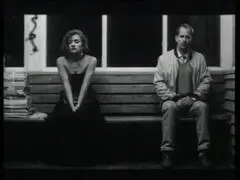
Fig. 1: Boy meets girl – with nothing happening (0:03:26)
There is no third person, no erotic competition in a so-called love triangle. These two do not unleash animal instincts for sex on the spot. There is no high-pitched scream out of the blackout as she is being slashed and slaughtered by the infamous tram-stop-killer. The woman, for her part, does not turn out to be some psychosexual maniac like Glenn Close in Adrian Lyne’s FATAL ATTRACTION (1987). These two do not even talk, for heaven’s sake! A man and a woman, roughly the same age, both decent- to good-looking, both smokers, both stranded at some forsaken tram stop. Why can’t he just hand her his jacket, saying something like: »You must be freezing – want my jacket for a while?« The man acts inhibited, perhaps intimidated by her flashiness and self-assurance. His gingerly efforts to establish contact – the small change, the matches, the jacket – they all fail. Even smoking provides no ground for some harmless talk.
A useful task here would be to describe and to characterize the protagonists, perhaps like this: While the man is a »regular guy«, average, shy, timid, the woman comes across flashy, extravagant (note her dress, and she also sports a tattoo on her arm), self-assured, perhaps even a bit perky. Explaining the characters and their quiet drama also has to take into account some means of filmic representation: First of all, the fictional world is in black and white, not colorful and vivid. Secondly, music and camera movement structure the sequence of events. Each time an effort at making contact has failed, the camera pulls back (from the take we see in Fig. 1) into a medium long shot, while a sequence of elegiac guitar chords can be heard. Thirdly, close-ups and detail shots are used for emphasis: the woman’s goose bumps and their close perception by the man through subjective camera; or the grinding out of a cigarette butt.
Camera movement, field size and shot length combine suggestively when the man notices the nearby laughter. The film takes ten long seconds to zoom into a close-up of the man’s face and it holds that close-up for another eight seconds before the man starts smiling. It is often held against film that everything is shown and therefore nothing left to imagine, no gaps to be filled in. Here is a striking example to the contrary: What is going on in the man’s mind at this moment? Let us fill an imaginary thought bubble: »Man, those guys seem to be having some fun. And I can’t even speak to this nice woman, who is obviously freezing? What is my problem? Why can’t I give her my goddamn jacket? Jesus, what is wrong with me? Now come on!«
Читать дальше
